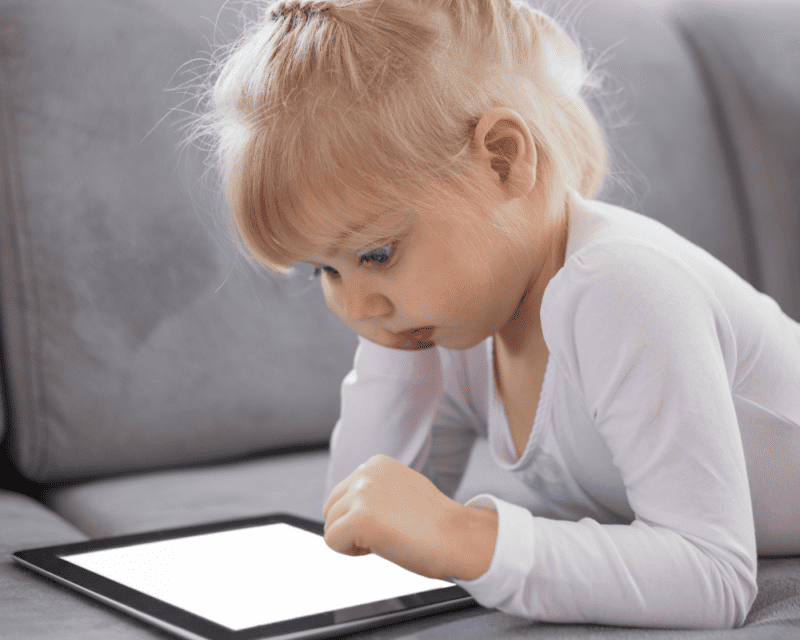In the digital age, understanding the impact of technology on child development is crucial. As digital devices become ubiquitous in the lives of young children, they have a profound influence on various aspects of growth and learning. This integration raises important questions about the benefits of technology to shape cognitive, social, and emotional development. From interactive educational apps to the potential challenges of screen time, the role of technology in children’s lives is multifaceted and significant. This article explores these dimensions, aiming to provide insights into the positive and negative aspects of technology’s impact on the developmental journey of children in today’s digital world.
The Digital Landscape and Young Children

The landscape of childhood has transformed dramatically with the advent of digital technology. Today’s young children are growing up in a world where mobile devices are a common aspect of their daily lives. From tablets and smartphones to the latest interactive learning tools, these digital technologies are an integral part of the modern child’s experience.
This prevalence is not without its implications. While these devices offer unprecedented access to educational resources and interactive learning, they also present challenges that previous generations never encountered. The ease of access to mobile devices has reshaped the way children interact with the world, learn new concepts, and develop essential skills.
As we delve into this new reality, it’s crucial to understand how the omnipresence of digital technology is shaping the early experiences and development of children today. This section explores both the opportunities and challenges presented by this digital immersion, setting the stage for a deeper discussion on its multifaceted impact on child development.
Positive Impacts of Technology on Development
The positive effects of technology on child development, particularly in cognitive and social aspects, are increasingly evident. Digital tools, including a variety of educational apps, have become instrumental in enhancing learning experiences and fostering cognitive development. These tools offer children interactive and personalized learning opportunities that were once unimaginable, allowing them to develop critical thinking problem-solving skills, and a deeper understanding of complex concepts at a young age.
Furthermore, technology plays a vital role in developing social skills. Through interactive games and online platforms, children learn to communicate, collaborate, and engage with peers across diverse settings. This exposure aids in nurturing empathy, understanding different perspectives, and building a sense of global community. The digital environment, when navigated wisely, can offer children unique opportunities to develop and hone their social and emotional skills in ways that complement traditional learning methods.
In essence, when used thoughtfully, technology can be a powerful ally in a child’s developmental journey, providing a multitude of resources and experiences that contribute positively to their cognitive and social growth.
Balancing Screen Time and Physical Activity

A critical aspect of integrating technology into children’s lives is finding the right balance between screen time and physical activity. The American Academy of Pediatrics provides clear guidelines to help navigate this balance. These guidelines emphasize the importance of limiting screen time for children, advocating for a structured approach that includes ample time for physical activities essential for physical health and development.
Physical activity is not just crucial for maintaining physical health; it also plays a significant role in cognitive and emotional well-being. Regular physical activities help in developing motor skills, enhancing concentration, and reducing the risk of obesity and related health issues. In contrast, excessive screen time can lead to a sedentary lifestyle, which is a growing concern in the digital age.
Therefore, it’s vital for parents, educators, and caregivers to encourage a healthy mix of physical play and the use of digital devices. By setting reasonable limits on screen time and prioritizing active play, children can enjoy the benefits of digital technology while also staying physically active and healthy.
Enhancing Learning and Skills Through Technology
Educational games and apps play a pivotal role in enhancing the learning experience of children, offering an engaging and interactive way to develop new skills. These digital tools are designed not only to educate but also to inspire curiosity and creativity in young learners. Through educational games, children can explore a range of subjects, from math and science to language arts, in a fun and captivating environment.
The use of technology in education extends beyond traditional learning methods, allowing children to acquire language skills, problem-solving abilities, and critical thinking through interactive and immersive experiences. Educational apps, in particular, offer personalized learning paths that adapt to each child’s pace and style of learning, making education more accessible and effective.
These digital platforms provide an innovative approach to learning, where children can gain valuable skills that are essential in the modern world. By integrating technology into education, we equip children with the tools and knowledge they need to succeed in a rapidly evolving digital landscape.
Social Media, Interactions, and Mental Health

Social media and online interactions have a profound impact on children’s mental health and social development. These digital platforms offer unique opportunities for socialization, enabling children to connect with peers and engage with wider communities. However, it’s important to recognize the dual nature of these interactions.
On the positive side, social media can enhance social development by fostering connections with peers, promoting empathy through understanding diverse perspectives, and providing platforms for self-expression and creative sharing. These interactions can be beneficial for developing communication skills and a sense of belonging.
Conversely, the impact of social media on mental health can be complex. Excessive or inappropriate use can lead to issues like cyberbullying, social anxiety, and a distorted perception of reality, potentially affecting self-esteem and emotional well-being. It’s crucial for parents and educators to guide children in navigating these platforms responsibly and to monitor for signs of mental health distress.
Risks and Negative Impacts of Excessive Tech Use
While technology offers numerous benefits, excessive screen time and tech use can lead to significant negative impacts, especially in children. One of the primary concerns is the promotion of a sedentary lifestyle. Prolonged periods of inactivity, often associated with excessive use of digital devices, can contribute to health issues such as obesity, poor posture, and related physical problems.
Another significant impact is on attention spans. The instant gratification and rapid pace of digital content can lead to reduced attention spans in children. This change can affect their ability to concentrate on tasks, learn new information, and engage in prolonged activities that require sustained focus.
Additionally, overuse of technology can also have implications for mental health. It can contribute to increased feelings of anxiety, depression, and social isolation, particularly when it replaces face-to-face interactions and physical activities.
It’s crucial to acknowledge these potential risks and take proactive steps to mitigate them. Balancing technology use with physical activities, setting screen time limits, and encouraging other forms of engagement are essential strategies to prevent these negative impacts.
Technology as a Tool for Family Bonding

Technology, often perceived as a solitary pursuit, can also be a powerful tool for strengthening family bonds. Interactive media and digital platforms provide unique opportunities for family members to connect and engage with each other, even when physically apart.
One of the most significant ways technology aids in family bonding is through video calls. These calls enable family members to maintain a visual and emotional connection, share experiences, and communicate in real time, regardless of distance. They are particularly valuable for families with members who live far apart or are unable to meet frequently.
In addition to video calls, various interactive media platforms offer opportunities for families to enjoy shared experiences. From playing online games together to participating in educational activities or exploring new digital hobbies, technology offers a plethora of ways to spend quality time, learn together, and create lasting memories.
By leveraging these digital tools, families can enhance their social connection, bridge gaps, and foster a sense of closeness and unity, making technology an integral part of nurturing family relationships in the modern world.
Preparing for the Future
In an increasingly digital world, equipping children with the right skills and knowledge for future careers is essential. Technology plays a crucial role in this preparation, offering both a learning platform and a field of future opportunities.
Through interactive learning tools and digital resources, children develop critical thinking and problem-solving skills that are highly valued in the modern workforce. These skills are not just applicable to technology-based careers but are fundamental across various sectors. As the digital landscape evolves, adaptability and the ability to navigate and utilize technology efficiently become indispensable.
Moreover, exposure to technology from a young age familiarizes children with digital environments, preparing them for a future where digital literacy is a basic requirement. Whether it’s coding, digital design, online collaboration, or simply the effective use of digital tools, these competencies are integral to success in almost every career path in the 21st century.
In summary, the integration of technology in education is key to preparing children for future careers. It fosters essential skills and ensures they are adept at navigating a world where technology is ubiquitous.
Conclusion

The journey through the digital landscape in child development underscores the necessity of a balanced approach to technology use. While technology undeniably brings numerous benefits, enriching children’s lives with important skills and positive impacts, it’s essential to navigate its use judiciously.
A balanced approach ensures that while children reap the advantages of digital tools in developing critical thinking, creativity, and connectivity, they also remain engaged in physical activities, face-to-face social interactions, and other non-digital experiences that are vital for well-rounded development.
Ultimately, the goal is to integrate technology in a way that enhances children’s lives, supporting their growth into well-adapted, knowledgeable, and skilful individuals in the digital era. This balance is key to leveraging technology as a positive force in our children’s developmental journey.
Additional Resources and References
For those seeking additional information and deeper insights into the role of technology in child development, there are several authoritative sources available. These resources provide valuable guidance on digital literacy, educational technology, and balanced tech use for children:
Common Sense Media
An invaluable resource for parents and educators, Common Sense Media offers reviews, advice, and tools related to media and technology. Their comprehensive guides help in making informed decisions about media and tech in children’s lives. Visit Common Sense Media
American Academy of Pediatrics
This organization provides research-based guidelines and advice on various aspects of child health, including technology use. Their recommendations on screen time and digital engagement are essential for parents and caregivers. Visit American Academy of Pediatrics
International Society for Technology in Education (ISTE)
ISTE is a leading advocate for educational technology, offering resources and standards for integrating technology in education effectively. Visit ISTE
The Child Mind Institute
This organization provides articles and resources on the impact of digital media on mental health and development in children. Visit The Child Mind Institute
Edutopia
Run by the George Lucas Educational Foundation, Edutopia shares insights and practical strategies for using technology to enhance learning experiences in K-12 education. Visit Edutopia
By exploring these resources, parents, educators, and caregivers can gain a more comprehensive understanding of how to navigate the digital world in a way that benefits and supports children’s development.
This post was featured by Twinkl in their Tech Trends article

